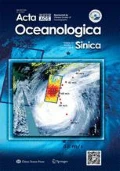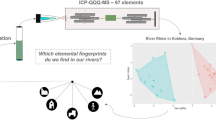Abstract
In some studies, the researchers pretreated and measured organic carbon, nitrogen and their isotopes (δ13C and δ15N) of marine sediment together, to save costs and resources of analysis. However, the procedure of acidification to remove inorganic carbon for analysing δ13C can affect the values of nitrogen and δ15N, and the biases vary a lot depending on the CaCO3 contents of sediments. In this study, the biases of total nitrogen (TN) and δ15N values arising from acidified sediments were compared between the CaCO3-poor (1%–16%) and CaCO3- rich (20%–40%) samples. TN and δ15N values were altered during acid treatment (without centrifugation) that possibly led to N-containing compounds volatilization. For CaCO3-poor samples, acidification led to a range of 0%–40% TN losses and 0‰–2‰ shift in δ15N values; and 10%–60% TN losses and 1‰–14‰ shift in δ15N values for CaCO3-rich samples. The biases from most samples exceeded the precision of the instrument (0.002% for TN and 0.08‰ for δ15N), and high biases could mislead our judgment for the environmental implication of the data. Thus, avoiding co-analysis of organic carbon, nitrogen and their isotopes (δ13C and δ15N) in sediments, even for CaCO3- poor marine sediments, is necessary.
Similar content being viewed by others
References
Baldock J A, Skjemstad J O. 2000. Role of the soil matrix and minerals in protecting natural organic materials against biological attack. Organic Geochemistry, 31(7–8): 697–710
Brodie C R, Heaton T H E, Leng M J, et al. 2011a. Evidence for bias in measured δ15N values of terrestrial and aquatic organic materials due to pre–analysis acid treatment methods. Rapid Communications in Mass Spectrometry, 25(8): 1089–1099
Brodie C R, Leng M J, Casford J S L, et al. 2011b. Evidence for bias in C and N concentrations and δ13C composition of terrestrial and aquatic organic materials due to pre–analysis acid preparation methods. Chemical Geology, 282(3–4): 67–83
Bunn S E, Loneragan N R, Kempster M A. 1995. Effects of acid washing on stable isotope ratios of C and N in penaeid shrimp and seagrass: Implications for food–web studies using multiple stable isotopes. Limnology and Oceanography, 40(3): 622–625
Fernandes M, Krull E. 2008. How does acid treatment to remove carbonates affect the isotopic and elemental composition of soils and sediments?. Environmental Chemistry, 5(1): 33–39
Froelich P N. 1980. Analysis of organic carbon in marine sediment. Limnology and Oceanography, 25(3): 564–572
Harris D, Horwáth W R, Van Kessel C. 2001. Acid fumigation of soils to remove carbonates prior to total organic carbon or carbon–13 isotopic analysis. Soil Science Society of America, 65(6): 1853–1856
Hu Jianfang, Peng Ping’an, Jia Guodong, et al. 2006. Distribution and sources of organic carbon, nitrogen and their isotopes in sediments of the subtropical Pearl River estuary and adjacent shelf, Southern China. Marine Chemistry, 98(2–4): 274–285
Jacob U, Mintenbeck K, Brey T, et al. 2005. Stable isotope food web studies: a case for standardized sample treatment. Marine Ecology Progress Series, 287: 251–253
Jaschinski S, Hansen T, Sommer U. 2008. Effects of acidification in multiple stable isotope analyses. Limnology and Oceanography: Methods, 6(1): 12–15
Kennedy P, Kennedy H, Papadimitriou S. 2005. The effect of acidification on the determination of organic carbon, total nitrogen and their stable isotopic composition in algae and marine sediment. Rapid Communications in Mass Spectrometry, 19(8): 1063–1068
Lohse L, Kloosterhuis R T, De Stigter H C, et al. 2000. Carbonate removal by acidification causes loss of nitrogenous compounds in continental margin sediments. Marine Chemistry, 69(3–4): 193–201
Lorrain A, Savoye N, Chauvaud L, et al. 2003. Decarbonation and preservation method for the analysis of organic C and N contents and stable isotope ratios of low–carbonated suspended particulate material. Analytica Chimica Acta, 491(2): 125–133
Middelburg J J, Nieuwenhuize J. 1998. Carbon and nitrogen stable isotopes in suspended matter and sediments from the Schelde Estuary. Marine Chemistry, 60(3–4): 217–225
Peng Yajun, Wang Yujue, Liu Dongyan, et al. 2015. Acid treatment effects on the carbon stable isotope values of marine sediments. Acta Oceanologica Sinica (in Chinese), 37(12): 77–84
Ridgwell A, Hargreaves J C. 2007. Regulation of atmospheric CO2 by deep–sea sediments in an Earth system model. Global Biogeochemical Cycles, 21(2): GB008, doi: 10.1029/2006GB002764
Ryba S A, Burgess R M. 2002. Effects of sample preparation on the measurement of organic carbon, hydrogen, nitrogen, sulfur, and oxygen concentrations in marine sediments. Chemosphere, 48(1): 139–147
Savage C. 2005. Tracing the influence of sewage nitrogen in a coastal ecosystem using stable nitrogen isotopes. AMBIO: A Journal of the Human Environment, 34(2): 145–150
Schlacher T A, Connolly R M. 2014. Effects of acid treatment on carbon and nitrogen stable isotope ratios in ecological samples: a review and synthesis. Methods in Ecology and Evolution, 5(6): 541–550
Schmidt M W I, Gleixner G. 2005. Carbon and nitrogen isotope composition of bulk soils, particle–size fractions and organic material after treatment with hydrofluoric acid. European Journal of Soil Science, 56(3): 407–416
Schubert C J, Calvert S E. 2001. Nitrogen and carbon isotopic composition of marine and terrestrial organic matter in Arctic Ocean sediments: implications for nutrient utilization and organic matter composition. Deep Sea Research Part I: Oceanographic Research Papers, 48(3): 789–810
Schubert C J, Nielsen B. 2000. Effects of decarbonation treatments on δ13C values in marine sediments. Marine Chemistry, 72(1): 55–59
Serrano O, Serrano L, Mateo M A, et al. 2008. Acid washing effect on elemental and isotopic composition of whole beach arthropods: implications for food web studies using stable isotopes. Acta Oecologica, 34(1): 89–96
Stein R, Grobe H, Wahsner M. 1994. Organic carbon, carbonate, and clay mineral distributions in eastern central Arctic Ocean surface sediments. Marine Geology, 119(3–4): 269–285
Sweeney R E, Kaplan I R. 1980. Natural abundances of 15N as a source indicator for near–shore marine sedimentary and dissolved nitrogen. Marine Chemistry, 9(2): 81–94
Tucker J, Sheats N, Giblin A E, et al. 1999. Using stable isotopes to trace sewage–derived material through Boston harbor and Massachusetts bay. Marine Environmental Research, 48(4–5): 353–375
Voss M, Larsen B, Leivuori M, et al. 2000. Stable isotope signals of eutrophication in Baltic Sea sediments. Journal of Marine Systems, 25(3–4): 287–298
Wang Yujue, Liu Dongyan, Richard P, et al. 2013. A geochemical record of environmental changes in sediments from Sishili Bay, northern Yellow Sea, China: Anthropogenic influence on organic matter sources and composition over the last 100 years. Marine Pollution Bulletin, 77(1–2): 227–236
Author information
Authors and Affiliations
Corresponding author
Additional information
Foundation item: The National Natural Science Foundation of China under contract No. 41376121; the Strategic Priority Research Program of the Chinese Academy of Sciences under contract No. XDA11020405; the Natural Science Foundation of Shandong Province under contract No. JQ201414; the Program of Advanced Talents of The Guizhou University of Finance and Economics, 2016.
Rights and permissions
About this article
Cite this article
Peng, Y., Liu, D., Wang, Y. et al. Analyzing biases of nitrogen contents and δ15N values arising from acidified marine sediments with different CaCO3 concentrations. Acta Oceanol. Sin. 37, 1–5 (2018). https://doi.org/10.1007/s13131-018-1188-2
Received:
Accepted:
Published:
Issue Date:
DOI: https://doi.org/10.1007/s13131-018-1188-2




